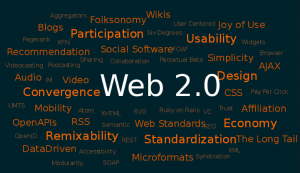
(Thanks to our Association Time Transporter, we’ve been able to bring Sherlock Holmes and his steadfast companion, Dr. Watson, up to present day to address the issue of Web 2.0.)
“First of all, Watson, let’s define our terms,” said the lanky man with the pipe and the funny hat. “What, Watson, is Web Two Point OH?,” Mr. Holmes asked.
Watson’s eyes traveled back and forth across the floor, as if he would find the answer walking across the floor on the back of an ill-fated mouse.
“Falling asleep, old friend?” Sherlock remarked, snapping Watson out of his swamp of confusion. “Web Two Point Zero, according to Wikipedia,” Holmes began, “is commonly associated with web development and web design that facilitates interactive information sharing, interoperability, user-centered design and collaboration on the World Wide Web. Examples of Web 2.0 include communities, hosted services, web applications, social-networking sites, video-sharing sites, wikis, blogs, mashups and folksonomies. A Web 2.0 site allows its users to interact with other users or to change website content, in contrast to non-interactive websites where users are limited to the passive viewing of information that is provided to them.
The term is closely associated with Tim O’Reilly because of the O’Reilly Media Web 2.0 conference in 2004.’ I’ve drawn up a simple slide that conveys this concept.”
Holmes lit the candle in the lamp of an early day, slide projector. A slide (below) appeared on the screen.

Watson snored quietly in the corner as Sherlock continued.
“What this means, Watson, is that Web 2.0 has enabled all of us to become article publishers, blographers, videographers, public relations people…all exchanging viewpoints and media and….”
Watson’s snoring came to a choking halt as Holmes kicked his foot.
“Do you not realize, Watson, the tremendous communication capability at your fingertips and the size of the potential network you can create?”
Watson shirked. “But, I’ve got nothing interesting to say.”
“Then, we must find out what people think is interesting, and write about that,” Holmes concluded. Watson looked exasperated. Watson’s problem is shared by many.
What do you say that will be interesting? What do you communicate that will be relevant? If your communication is not “relevant” then you’re just wasting your time and your money. The promise of Web 2.0 is to have followers and friends and fans gathering around, intrigued by the media you’re sending out. Waiting for your ‘tweets’.
Wouldn’t it be great to know just what to say, what pictures to show? So, how do you create an effective social media marketing plan that is relevant to your target audiences as part of an market development strategy?
Well, as Holmes said, it starts with some detective work. We have a team. We do market research data collection and surveys before we start the creative design of social media. In fact, we do it before any marketing campaign.
Our market research director, has done thousands of surveys and uncovers the most fascinating data. Her primary and secondary research has helped us create campaigns that were right on target, saving our clients hundreds of thousands of dollars. Here’s a quick case study. An Attorney wanted to reach prospects who had been abused by debt collectors. We surveyed his target audience and specifically asked them, “If you had a valid case of debt collector abuse, would you turn to an attorney for help?”
Over 60% said ‘No’. We asked why.
The answer? “I don’t trust attorneys.”
So our campaign didn’t show an attorney, sitting at his desk shot with law books in a bookcase behind him.Instead, we showed a group of ’consumer advocates’.
The strategy worked. 343 reaches in first 3 days in a two-prong campaign on the web and on TV.
But if we’d neglected to get professional marketing research done, our attorney friend would have thrown a lot of money into a “standard” attorney marketing concept that wasn’t relevant to his target audience. Not only that, when the market for debt collection services changed, we applied the same research to a new spot highlighting the company’s lemon law services, as shown in the video below:
So, if you want to be “relevant” to your target audience, you need good, professional Market Research data collection. Elementary.
